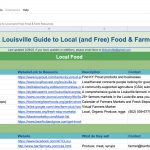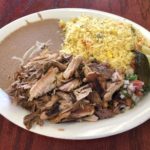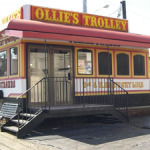A year ago, Adam Barr’s free-range hens were a culinary secret known to a lucky few. An email would arrive: “Adam’s got chickens!” Quietly, almost furtively, we’d line up at the Phoenix Hill Farmers Market and wait for the young farmer from Rhodelia, Ky., to show up with coolers full of plump, juicy chickens in the back of his pickup truck.
These hens were as good as the fabled French poulet de Bresse, and hardly anybody knew about them. We wanted to support Adam, but we were reluctant to talk about them too openly, for fear there wouldn’t be enough for us.
Well, damn.
One year later, we can still chow down on an Adam Barr hen, but now we go to local eateries like Harvest, Meridian Café and Eiderdown to get it. Barr’s annual production of 1,800 hens used to last pretty much year ‘round. Now he sells out fast to a handful of restaurant clients — and when they’re gone, they’re gone.
This little story, in a nutshell, tells the tale of locavore dining in Louisville. Once the trademark of only a handful of restaurants, it seems that just about every independent local eatery is now eagerly shrinking its carbon footprint, reaching out to regional farmers to source everything from meat and poultry to veggies, fruit and even wine.
“In Kentucky, we have the advantage of a lot of farms, and most of them are small,” says Ivor Chodkowski, a local leader in the farm-to-table movement, a Jefferson County farmer who this year opened Harvest restaurant, one of the hottest new tickets on the local dining scene, with its bill of fare based almost entirely on locally grown meat and produce. Chodkowski believes the community has “hit a critical mass of interest in local food.”
A number of factors contribute to this development: There’s been a boom in farmers markets, from one or two in the early ’90s to more than two dozen today, with markets open every day throughout the Metro during the growing season.
Community-supported agriculture programs have made it easy to get local produce, as have farm-fare distribution programs like Grasshoppers, which Chodkowski helped found. The Kentucky Agricultural Development Board has helped Kentucky farmers move from tobacco farming into high-value alternative crops, and a wealth of books, movies and documentaries, like Michael Pollan’s “Omnivore’s Dilemma” and the movie “Food, Inc.,” have raised public awareness about factory farming and corporate food distribution.
Of course, local produce is not exactly an innovation in these parts. Gettelfinger Farm in Southern Indiana, for example, was supplying Louisville restaurants generations before Marin County, Calif., food writer Jessica Prentice coined the word “locavore” in 2005.
Kathy Cary may have been the first Louisville restaurateur to celebrate local produce, though, adding “God bless our local farmers” to the menu when she opened Lilly’s in 1988. Local produce was already becoming trendy then, but it was seen as a California thing, spearheaded by hippies like Alice Waters at Berkeley’s Chez Panisse. Cary, raised on a farm in Oldham County, says she simply did what came naturally to a young woman who grew up picking vegetables and collecting eggs in the backyard.
Chef Jim Gerhardt, now at Limestone, earned applause when he brought local sourcing to the Seelbach Hotel’s Oakroom in the ’90s. Capriole Indiana goat cheese and Kenny Mattingly’s Kentucky cheeses started turning up on menus; so did Blue Dog bread, Sheltowee Farm mushrooms, Weisenberger Mill grits and more. The trend accelerated as local beef producers like DreamCatcher and Foxhollow Farm got into the business; Steve Wilson and Laura Lee Brown’s Kentucky Bison Co. made buffalo burgers commonplace on Louisville restaurant tables.
Now excitement grows as more local chefs sign on, from ethnic favorites such as Mayan Café to popular spots like Uptown Café, Marketplace at Theater Square, and even such upscale eateries as 610 Magnolia.
For Chef Mike Ross at Meridian Café, it was a family thing: “The birth of my kiddos is when it started about five months ago,” he says. “In looking for the best quality food to feed my children, it opened my eyes to what I’m eating as well as what my kids eat. It’s all about trying to eat better … people are becoming much more educated as to what you should be putting in your body.
“People say, ‘A chicken is just a chicken,’” Ross continues, “but Adam Barr is not pumping his chickens full of saline water before he freezes them. You can ask him what he’s feeding his chickens, and he can tell you. You know the conditions of his farm — how much he cares about the product he’s giving you. It’s a really nice product you can feel good about eating and serving, a nicer flavor, a much better product.”
And that, it seems, is the bottom line for many local chefs. Mozz makes its cheeses from Kentucky-produced milk. Chefs at Porcini, Proof on Main, Volare and many more pluck perfect veggies from their home gardens.
At Westport General Store, owner Will Crawford says his renewed commitment to local produce honors both quality and his neighborhood’s history as a significant agricultural area. The major suppliers couldn’t tell him where their food came from, Crawford says. “That is when I thought it would be cool to see the food being raised that I was going to sell.”
At Anchorage Café, Chef Andy Myers’ tapas menu uses local produce, and he says the response has been strong. “People care more now than they have in the past, and I don’t think that it is just another food trend,” he says.
Now chefs are clamoring for more. At 60 West, Chef Dustin Staggers says, “I’d love to use local farms for my other beef products besides ground beef and short ribs, but … they do not kill enough steers to provide my restaurant with enough tenderloin to sell. If that were an option, 60 West would be on board without hesitation.”
The farmers say they’re working to fill the need. “Sure, there will be bumps along the way,” Chodkowski says. “But it’s fully my expectation that suppliers will grow. I don’t see us contracting soon.”
This story was published in LEO’s Dining Guide 2011.



